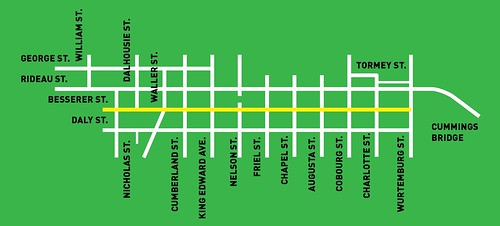We recently received a request to look into Sandy Hill’s Besserer Street. It’s not one of the most noticeable streets in town. Even though it outlines the northern edge of Sandy Hill as it runs from Daly (originally from Sussex Drive) to Wurtemburg Street near the Rideau River, it is busy Rideau Street a block to the north that defines the boundary of the district for most Ottawans.
After some digging into assorted books and web pages, though, it seems we once more have proof that author Will Ferguson was right: Canadian history cannot possibly be boring. It’s just a matter of knowing where and how to look for the key details.
Therefore, consider this man: Louis-Théodore Besserer…born a child of Québec in 1785, veteran of the War of 1812, doomed to self-imposed exile in Bytown as a consequence of his stance on the Rebellions of 1837.
The child of mixed German and French-Canadian parents, his early life was unremarkable by all accounts. He became first a student at the Petit Séminaire de Québec and eventually became a public notary in 1810, developing a decent reputation within the field.
Then came the War of 1812. His service earned him a promotion from Lieutenant to Captain by 1813, and by the end of it earned a land grant for his pains. Nonetheless, he got back to the normal business of being a notary and raising a family with his first wife, Angèle Rhéaume. By 1833, he found himself serving in the House of Assembly representing his home district.
The Papineau Rebellion of 1837 is where life in Québec fell apart for him. He agreed with the Ninety-Two Resolutions of 1834 calling for specific reforms in how the province was governed, but not with Louis-Joseph Papineau’s call to arms over the refusal of them by the Governor-General of Canada over the following three years. In the wake of the Rebellion, he found himself no longer welcome in Quebec, viewed almost as a traitor for that stance. While the British establishment of the day viewed Besserer in not much better light for having signed onto the Ninety-Two Resolutions, they didn’t have much reason to bar him from Ontario and after his first wife died, he lost his last reason to stay.
In 1845, he came to Bytown and took up residence on an estate purchased back in 1828, which was already in the process of being subdivided and sold off. That process, begun in 1838 under Besserer’s agent, William Stewart, was now accelerated, due in part to Besserer’s donation of a parcel to Bishop Patrick Phelan for the creation of a local church and school.
Somewhere along the way, Besserer found a second wife, Marguerite Cameron of Bytown, and continued fathering children and building what became known first as Besserer Place and, later still, as Sandy Hill.
He died the founder of Ottawa’s third neighbourhood, which began as a cause of contention, given the ethnic and religious tensions of the time. Sandy Hill’s creation disrupted the vote gerrymandering of the original settlement, which had ensured that the pro-Imperial sentiment in Uppertown dominated the local government, at the expense of fair representation for Lowertown residents. Also, the Shiners’ War between Irish and French logging industry workers further complicated the process of building that community.
Now, however, it is a far more peaceful place by comparison. Also, over the intervening century and a half, Sandy Hill is now the home of the University of Ottawa. His Ottawa home, Besserer House, stands to this day, even having served for a time as the Spanish Embassy to Canada.
No small legacy, that. Far more than a simple street sign suggests.


